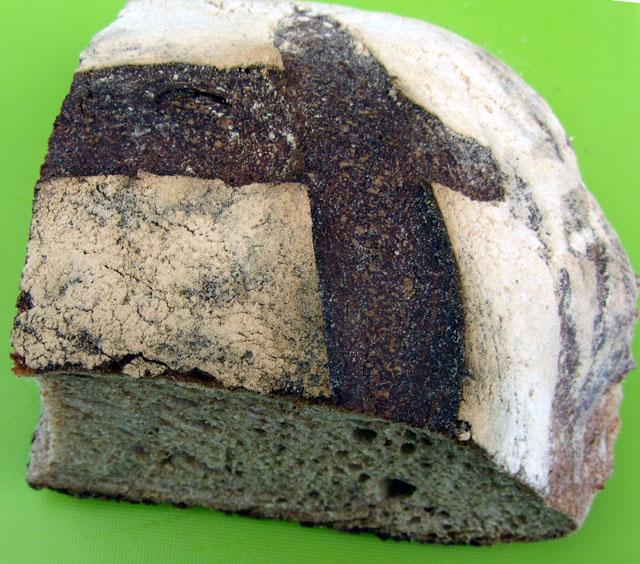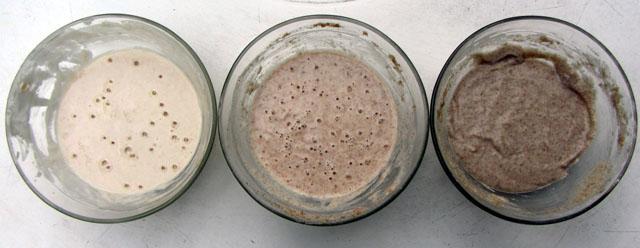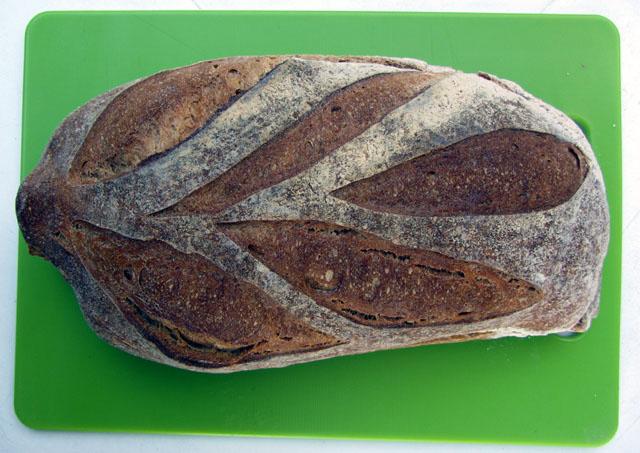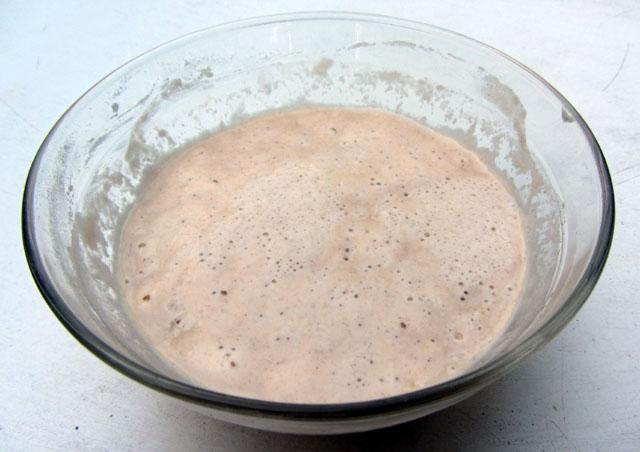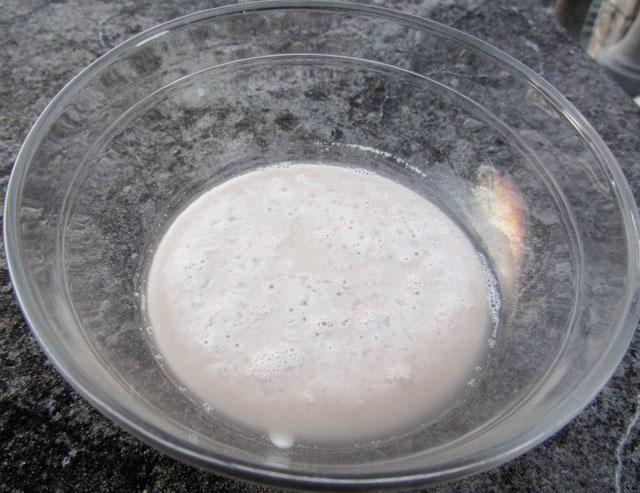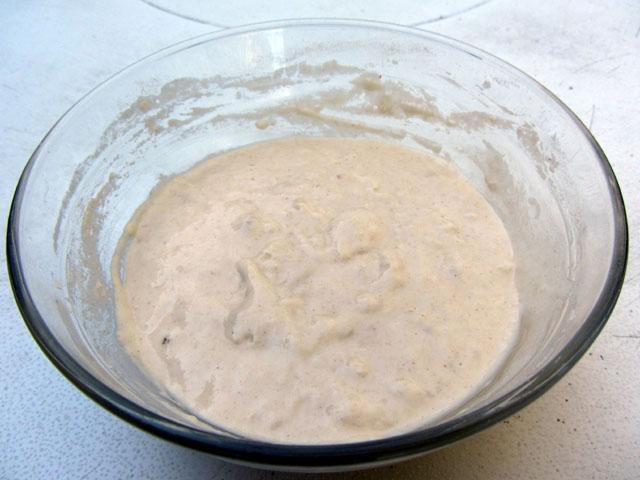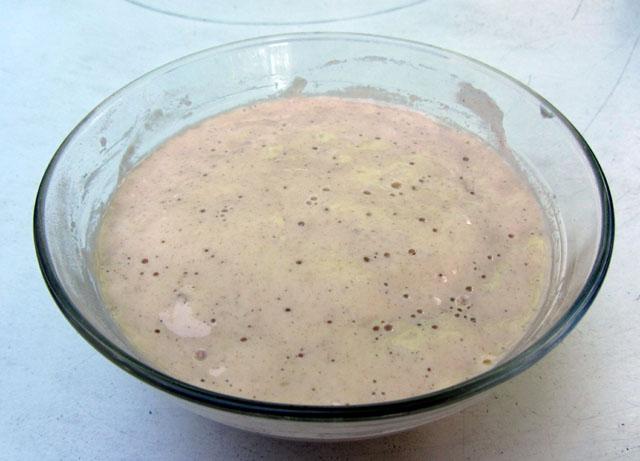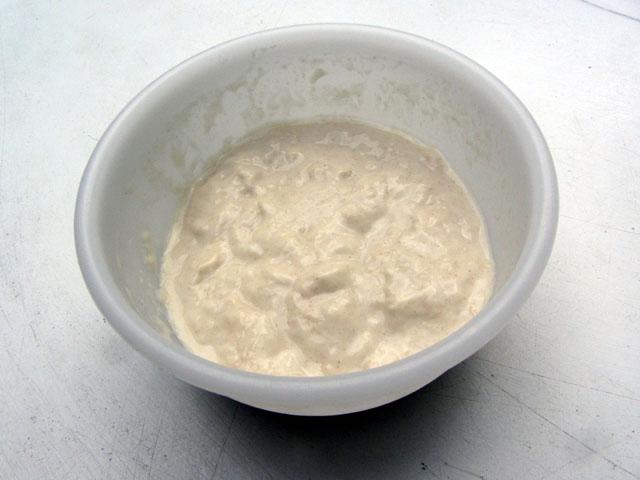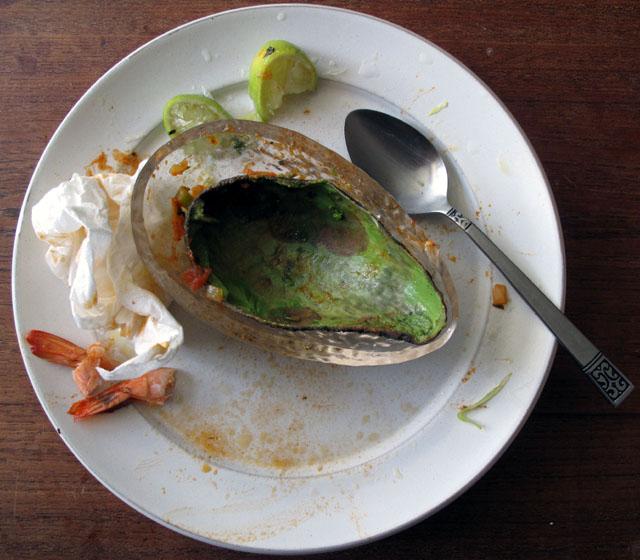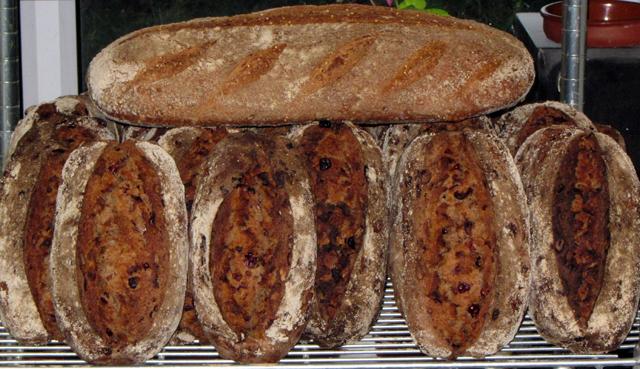
bethesdabakers
participating member-
Posts
239 -
Joined
-
Last visited
Content Type
Profiles
Forums
Store
Help Articles
Everything posted by bethesdabakers
-
You're right. Having to cope with bread like that is pretty hard. We're just going to round off the day with cheese on his wholemeal: I'm just using water straight from the tap because I just want to experiment with the basic ingredients. I'm not saying anything but the rye starter is looking just a little perky - probably just a starter joke.
-
I'm having more than just internet problems. My starter won't go beyond a certain stage of development but on the other hand it's not dying and smells sweet. Took drastic action on Saturday. Bought wholemeal and rye flours and split the starter in three: They are still just limping along so I shan't post again until there's a little more drama. In the mean time we have to put up with loaves like this: a semi-complet from Marc Brion of Biganos
-
Repost - I hope Hi Elsie - It's sitting in its little glass bowl, covered with clingfilm on a north-facing windowsill. That's because it's the only windowsill in this tiny studio. The weather has been pretty warm he this week ranging from about 22C-30C. Cakewalk - I knew someone would pick me up on that: No, we haven't had a sudden breakthrough. That's an old picture of an active starter. Obviously it's a close-up and taken for effect so don't judge your own by it. Unestablished starters tend to have individual bubbles that stand out from the rest of the mixture because there's not a lot of ferment going on. Back to the show: Thursday morning, 24 hours since its last refreshment, the starter is clearly active but still looking a bit limp. We are entering that period where after the initial excitement the mixture seems to hang around deciding whether to perform or not. Refreshed it with equal weights of flour and water, decided I had too much and dumped half, then, typically, decided perhaps I should have kept more. Thurday evening. We were invited for an aperitif with the owners of the studio in which we are staying and their neighbours. They have a magnificent house (where Napoleon III once stayed) with a grand white-pebble terrace immediately above the Bassin d’Arcachon – the evening was perfect, the tide was high, so we sat outside. There was more than one aperitif, the conversation flowed and there was a beautiful sunset to admire so that I nearly forgot my photographic duties. Hence the change of location to get the last available light. It’s looking a bit sad and it’s cast a little lake of hooch. I poured this away and refreshed it as before – equal weights of flour and water. We are holding our nerve!
-
Hi Elsie - It's sitting in its little glass bowl, covered with clingfilm on a north-facing windowsill. That's because it's the only windowsill in this tiny studio. The weather has been pretty warm he this week ranging from about 22C-30C. Cakewalk - I knew someone would pick me up on that: No, we haven't had a sudden breakthrough. That's an old picture of an active starter. Obviously it's a close-up and taken for effect so don't judge your own by it. Unestablished starters tend to have individual bubbles that stand out from the rest of the mixture because there's not a lot of ferment going on. Back to the show: Thursday morning, 24 hours since its last refreshment, the starter is clearly active but still looking a bit limp. We are entering that period where after the initial excitement the mixture seems to hang around deciding whether to perform or not. Refreshed it with equal weights of flour and water, decided I had too much and dumped half, then, typically, decided perhaps I should have kept more. Thurday evening. We were invited for an aperitif with the owners of the studio in which we are staying and their neighbours. They have a magnificent house (where Napoleon III once stayed) with a grand white-pebble terrace immediately above the Bassin d’Arcachon – the evening was perfect, the tide was high, so we sat outside. There was more than one aperitif, the conversation flowed and there was a beautiful sunset to admire so that I nearly forgot my photographic duties. Hence the change of location to get the last available light. It’s looking a bit sad and it’s cast a little lake of hooch. I poured this away and refreshed it as before – equal weights of flour and water. We are holding our nerve!
-
Thanks, Anna. That’s my mission in life – demystifying sourdough. If someone asks how to make a starter on a forum everyone chips in and confusion reigns. I thought if I start a new topic I have more control over the message. Pineapple is for rum punches, etc. Anyway we might need a bit of voodoo yet the way it’s looking. On with the story. Wednesday morning, i.e. 36 hours later - well, all right, nearer 40 hours - we are allowed a lie-in on our holidays, aren’t we? – it looked like this: The colour is probably a bit exaggerated in the photo. It was crusted with a very light mustardy tinge; hint of bubbles and smelling sweet. At this point I whipped out the scales (I didn’t arrive totally without gear) and mixed the paste with 50g water and 50g flour – about the same weight as the original mix – switched containers to glass and the covering to cling-film (again no relevance in the materials used). By Wednesday evening it looked like this – well bubbly but with that tell-tale immature look. Left it in peace overnight.
-
There’s a persistent myth that good bread is the norm in France. It is a myth which is why I bring my starter with me when we come on holiday from Wales. I’m definitely becoming a grumpy old sod. I was so annoyed by a stupid article in The Guardian newspaper just before we came away a few days ago - http://www.theguardian.com/lifeandstyle/shortcuts/2014/sep/03/who-will-babysit-my-sourdough-starter - that I thought, for the first time in about 15 years I’m not even going to take my starter, I’ll start from scratch and if I can’t get a starter going, it’s store-bought bread for the duration. Anyway, the four days since we arrived here on Saturday have been so perfect that we are probably never going back home to Wales. So I thought I’d better have a go with the starter. Monday evening I mixed two tablespoons of flour (organic T65 from the supermarket) with enough water to make a stirable paste in a little plastic pot and covered it with a piece of kitchen towel. If you are going to try this, please note that little of the foregoing is relevant – the amount of flour, the type of flour, the fact that it’s French, the type of container, the cover. You just need to make a paste of flour and water and it will either start to ferment or it won’t. If it won’t, you start again. You only have to do this once in your life so the odd false start is not a big deal. This is how it looked after mixing on Monday evening – doesn’t tell you much but I thought you might feel reassured by its ordinariness. Watch this space. I’m going to look pretty stupid if this doesn’t work. Mick
- 61 replies
-
- 10
-

-
Thanks for your replies but they illustrate my problem - lack of technical and programming skills. When ebooks first started coming available I thought their real use would be for reference books because of the search effectiveness of databases. So I thought things like cook books would be amongst the first to benefit. But if you take a service like Kindle, there's a very uneven spread of titles that get released in this form and there's no standard presentation or search facility. That's without the swamp of low-grade titles that gum up searches by browsing. But that's a side issue. I just wondered if any of you technically smart foodies out there knew of a simple software package suitable for producing ebooks that is particularly suited to e-cook books (even better if they would take interactive spreadsheets). Or even an example of a well-produced e-cook book. Thanks Mick
-
This is sort of a parallel topic to “How Do You Feel About Buying and Using E-Cookbooks?” I’ve written and self-published three books on sourdough bread and microbakery. I do pretty much everything, the bread formulas, the writing, the photographs, the layout. I have them printed to a high standard in small batches of 50-100 and I promote and sell them through my blog thepartisanbaker. I’m thinking about the future. The books sell steadily enough but I’m probably only covering my costs – that’s OK. Not having (or wanting) a television series I’ve pretty much given up on a publishing deal – like commercial yeast I’ve decided publishers are a distraction and surplus to requirements. I’ve now reached the stage where I’m selling almost as many pdf versions as hardcopy and I’m thinking of abandoning print and producing only electronic books. Again I’m only interested in selling direct and not going down the Kindle/Kobo route. Is anyone out there able to offer suggestions about software suitable for cook books, in particular software that would allow the inclusion of interactive spreadsheet tables. What I want to do is present bread formulas in tables that allow the user to change dough weights and quantities. Thanks for any suggestions – hope this is in the right forum.
-
So with spare prepared and cooked salt cod from the Pudim de Bacalhau com Ovos recipe, a couple of posts up, I made Avocado Diablo. Gently fried half an onion in butter and olive oil. Added garlic, tomato puree, a little sugar, coriander (cilantro), black pepper, half a large scotch bonnet and fried a little longer. Added the salt cod, a few raw prawns (shrimp), chopped green pepper and tomatoes, juice of half a lime and cooked until the prawns were just done. Served hot in avocado halves (two). Recipe from Kenneth Gardnier's Creole Caribbean Cooking. Didn't last long.
-
Pudim de Bacalhau com Ovos - sounds better than salt cod with eggs. A Brazilian dish from Elizabeth Lambert Ortiz “The Book of Latin American Cooking” Her quantities for six as a first course: ½lb salt cod 2 tablespoons cornflour (cornstarch) ¾ pint milk 2½ ounces butter 1 medium onion grated 2 medium tomatoes peeled, seeded and chopped 2 tablespoons capers Seasoning 6 eggs grated parmesan Did roughly half quantities. I used the not-stiff-as-a-board type of salt cod which doesn’t need so much soaking or cooking. Soaked the cod overnight changing the water two or three times. Covered it with boiling water, brought it back to the boil, covered and turned off the gas. Removed from the water after about 15 minutes, skinned and flaked. Melted some of the butter in a small pan, mixed a small amount of the milk with the cornflour, stirred in the rest, added to the pan with the butter, stirred till thickened. Melted the remaining butter in another pan fried the onion gently, added the tomato and reduced a little. Stirred in the sauce, cod and capers and allowed to cool. Preheated the oven to 200C (400F, Gas 6). In my case buttered two ramekins, broke an egg into each, covered with the cod mixture, sprinkled with parmesan, baked 8 minutes. A really nice combination of two of my favourites, salt cod and baked eggs.
-
Same way as you lose anything else. You put it down, move a few things around, forget it. Come to slash the next batch - no blade. I run bread courses, organise baking weekends. The more people the more chance of losing a blade. People put them down on aluminium pizza trays, i.e. they become invisible, dump them in proving baskets, you wouldn't believe it ...
-
Dan Lepard used to say, "slash like you're slashing a throat". People can be a bit tentative. Work out the line you are going to take, steady the dough with one hand and slash confidently with the other. There isn't really an answer to this question. There are a whole variety of doughs so one blade really isn't enough. At the end of the day you find what suits you and the different doughs. I use a razor blade because, if you hold it right, it's rigid and doesn't drag - just use a protruding corner - (can't get a grip on lames), or a really cheap (and viciously sharp) Victorinox tomato knife, or, for heavy miche-type loaves and straight lines, a scaloped bread knife. As regards razor blades and safety - I have a little metal tin - only one blade is allowed to be in use and it lives in the tin and the tin lives under a minature le creuset in which I keep grain for decorating wholemeals. The blade comes out to slash, goes back in the tin and the tin goes back under the le creuset. If the blade goes missing the whole batch gets scrapped. You need a bit of theatre to stay safe. Best wishes Mick
-
Hibiscus margaritas!
-
Cardiff: I used to know Cardiff a little ten years ago but it's all changed. Can anyone direct me to a hostelry equivalent to the Harker's in Chester, i.e. a reasonably civilised, large pub/brasserie, that serves half-decent food throughout the day, where there's no need to book in advance. I'm trying to organise a birthday party for myself, not knowing whether two people (including myself) or forty might turn up. It's not a match day or half-term. Thanks Mick
-
Oof! That's painful. There are lots of things you CAN do but why would you? The simplicity of the sourdough process is beautiful in itself. So what if it takes a few tries to get a starter going? Once it is fermenting, take a little care of it and it's yours for life. I had a mispent middle-age hanging around French boulangeries. It's not so easy. They are often small so there's nothing to see and as soon as you walk through the door, that crowd you were hoping to hide behind evaporates and the woman behind the counter wants to know your order. Get you own starter going and once it's established it will be as good as any veteran culture. A few years ago, on holiday in France, I spent some time trying out different methods. If you're interested you can read the account here Personally I'd stick with straight flour and water but it's a matter of choice. Mick
-
Flavors Of The Nile On Your Budget - a mere £1.88 on UK Amazon - didn't take a lot of buying.
-
Seeds/grains don't stick on baked breads! Any "glue" ideas?
bethesdabakers replied to a topic in Pastry & Baking
For seeds I just scatter them in the bottom of the proving basket. For a decent coating of oats have a tray with a wet tea towel in the bottom and a tray with plenty of oats. Roll the dough after shaping on the wet tea towel and then in the oats until completely coated. Mick -
Thanks. The problem isn't finding them - the wholesaler who supplies my flour and other ingredients stocks cranberries and pecans but they have become seriously expensive, like other nuts and grains. I'm sure that's not confined to the UK. As for the bourbon I follow my nose and hang the expense.
-
Bit late with the reply and I'm not sure if this is what you are looking for. Roast Goose with Confit Legs - in this recipe the legs are removed and the crown is cut away from the carcass. The carcass, wings, etc. are chopped up and roast with vegetables, legs on top, and the crown added later in the cooking. I used this recipe last Christmas - the first time I had roast a goose - and was pretty impressed. The mystery is, I found it on the net, I could have sworn it was Raymond Blanc and on the BBC Food site. When I came to look for it again it was nowhere to be found until I found it, unattributed, on this guy's site: http://southsea.uk.com/tst/index.php/recipes/28-meat/fowl/132-roast-goose-with-confit-legs
-
Thanksgiving Bread - rye and wheat flours, rye starter, pecans, cranberries, bourbon and orange juice. I'm in trouble with my American customers if the goods are not produced.
-
Well, thank you. Just when I thought I'd cured my cook book habit - I waited and followed the thread, eventually succumbed to the Kindle edition, then decided it had to be the book. A lot of people are getting pickled grapes this Christmas - just going to start on the apples before they are completely past it.
-
Experiments in Salt Rising Bread - or "oh my god what died in here
bethesdabakers replied to a topic in Pastry & Baking
Fabulous description! Mick -
If you haven’t been to Bordeaux for a while you might be pleasantly surprised by the way the city has improved. A few years back it was total chaos while they were building the tramway and developing the waterfront but now that is completed it’s a pleasure to stroll around. We usually spend time in Arcachon each year so Bordeaux experiences are normally day trips. Being creatures of habit (and wanting to get down to lunch) our routine is to take the tram into the centre, start at that wonderful independent bookshop, Mollat, on Rue Vital Carles, study the food section, and to start working our way back towards the station, maybe taking in the food books in FNAC on St Catherine (always hoping for a new bread book), cutting down towards St Michel, stopping to have a beer outside Utopia Cinema in the lovely sunny square, then drifting down through the streets of North African shops (trying not to buy another tagine) to the top of rue Porte de la Monnaie and inevitably into La Tupina for lunch. It has been a little fashionable of late to knock Tupina as an over-priced tourist restaurant but only by people who don’t know how to enjoy life. Jean-Pierre Xiradakis seems to own most of the street with Café Tupina on the bottom corner, La Tupina itself a few yards up, Le Comestible, the epicerie, and the hotel, Le Maison Fredon, opposite, Kuzina, the fish restaurant, further up the street, and Bar-Cave de la Monnaie on the next corner. An unusual source of information, so long as you have a Kindle, is to download for free, Bruno et le pere Noel by Martin Walker. At the end of the book he gives quite a detailed list of his favourite food places in the Bordeaux area. This includes Boeuf sur la Place in Pessac at the end of the tram line where we had an excellent lunch in May with the added bonus (for us) of discovering the Tuesday organic market both in the town square. The museum of contemporary art is worth going to see just for the building, never mind the exhibitions, and has a beautiful dining room up on the roof. Haven’t eaten there for a few years but it was pretty good – might only be lunch. Also on the tram is La Cape in Cenon if you want a gastronomic tasting menu. Being at the hub of the regional transport, it’s easy to use public transport to get out of the city to nearby towns and villages. Arcachon is only 50 minutes on the train – current favourite local restaurant Restaurant du Port in La Teste-de-Buche, the stop before Arcachon, within view of the station. Unpretentious, with a large covered terrace overlooking the port. Wish I had six months in Bordeaux.
-
Terrific!! Can't wait to see the comparative bread photos. Mick
-
Syzygies - Oh no, this is your game, I'm not playing. You want to vapourise 350g in your oven carry on, I'm very relaxed about the standard of my bread although, having put up my eveidence, JoNorvelleWalker thinks I could do better. I think that chains, rocks and stacked skillets are just a new distraction in a line of gimicks that confuse learning bakers. Baking good bread is a comparatively simple affair if people are able to pick their way through a minefield of misinformation. By the way, I'm not saying steam doesn't have a part to play in baking. I'm just saying that that the effects in domestic ovens is negligble (apart from lowering the temperature). Mick

